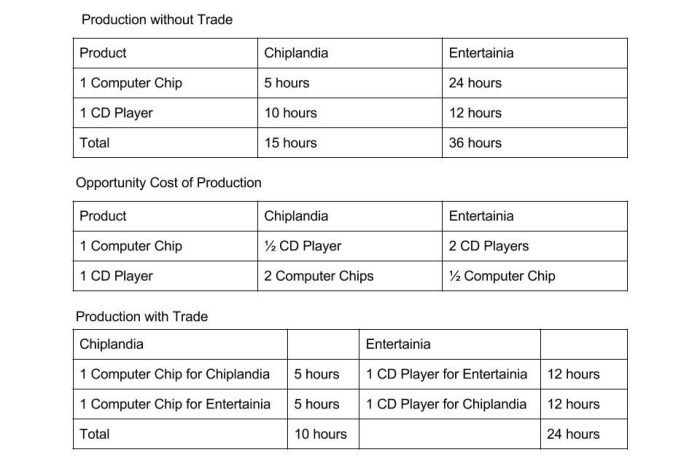Ap macro topic 1.3 comparative advantage and trade worksheet answers – Delve into the intricacies of international trade with our comprehensive guide to AP Macro Topic 1.3: Comparative Advantage and Trade Worksheet Answers. This resource provides a thorough understanding of the fundamental concepts that govern global commerce, empowering you to analyze and interpret trade patterns with confidence.
Our expert analysis explores the concepts of comparative advantage, absolute advantage, gains from trade, trade restrictions, and exchange rates, equipping you with the knowledge to assess the impact of trade policies on economies and businesses alike.
Comparative Advantage and Trade

Comparative advantage is a fundamental concept in international trade theory that explains why countries specialize in producing and exporting certain goods and services, even if they could produce them domestically at a lower cost. It is based on the principle of opportunity cost, which measures the value of the next best alternative that is foregone when a decision is made.
Comparative Advantage
- Comparative advantage refers to a country’s ability to produce a good or service at a lower opportunity cost than another country.
- Specialization and trade based on comparative advantage lead to increased production and consumption, as countries can focus on producing goods where they have a lower opportunity cost and trade for goods where they have a higher opportunity cost.
Absolute Advantage
- Absolute advantage refers to a country’s ability to produce a good or service using fewer resources than another country.
- Absolute advantage is not as important as comparative advantage in determining trade patterns.
- Even if a country has an absolute advantage in producing all goods, it can still benefit from trade if it specializes in producing goods where it has a comparative advantage.
Gains from Trade
- Trade can benefit both countries involved by increasing production and consumption.
- Consumer surplus is the benefit to consumers from buying goods at a lower price than they would have to pay if they produced the goods domestically.
- Producer surplus is the benefit to producers from selling goods at a higher price than they would receive if they sold the goods domestically.
Trade Restrictions
- Trade restrictions, such as tariffs and quotas, can protect domestic industries but also lead to higher prices for consumers.
- The arguments for free trade include increased economic growth, lower prices for consumers, and greater choice.
- The arguments against free trade include the potential for job losses in certain industries and increased competition for domestic producers.
Exchange Rates, Ap macro topic 1.3 comparative advantage and trade worksheet answers
- Exchange rates are the prices of one currency in terms of another currency.
- Exchange rates are determined by supply and demand for currencies.
- Fluctuations in exchange rates can affect trade and investment.
Questions and Answers: Ap Macro Topic 1.3 Comparative Advantage And Trade Worksheet Answers
What is comparative advantage?
Comparative advantage refers to a country’s ability to produce a good or service at a lower opportunity cost than another country.
How does specialization and trade lead to increased production and consumption?
Specialization allows countries to focus on producing goods and services in which they have a comparative advantage. Trade enables countries to exchange these goods and services, leading to increased overall production and consumption.
What are the arguments for and against free trade?
Proponents of free trade argue that it promotes economic growth, efficiency, and consumer choice. Opponents argue that it can lead to job losses, environmental degradation, and increased inequality.